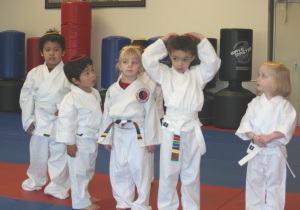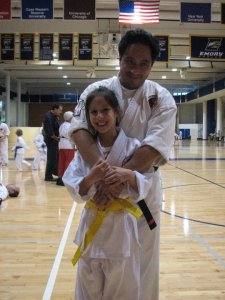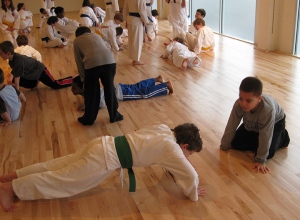Cuong Nhu IATC in Raleigh was a great opportunity for a group of instructors who teach kids to meet together to discuss common interests and concerns. At dinner on Saturday, a group got together, prompted by the following question, posed a few weeks earlier by Sensei Michael Hornback of Hero Academy in Longwood, FL:
“I have an eight year old student who cannot consistently keep her hands closed on punches and blocks (I know the various teaching methods to achieve this, but still, there is no consistency). How would she fare in a testing situation that you preside over? Would she pass? Fail? Get probation? Be berated [or, sternly corrected on this obvious, basic error] – even though you may not know her personal history and efforts as a student?”
For discussion purposes, we agreed to limit the topic to “testing standards for children,” and not stray into “teaching methods for kids.” As important as it is to share, discuss and revisit all the tips and tricks we can use to improve performance and cure specific bad habits (like loose fists), we know that children will remain imperfect in predictably unpredictable ways, and the question will arise, again and again, what to do when an imperfect child comes up for testing. Do we advance them, or bring them to a stop? How do we decide what to do?
Present for some or all of the discussion: Senseis Doug Storm and Shawn McElroy of Sung Ming Shu Dojo in Atlanta; Sensei Parnee Frederick of Revolution Dojo in Appleton, WI; Sensei Estela Atalay of Nei Ching Dojo, Miami; Sensei Ron Thomas of Tallest Tree dojo in Gainesville, FL; Sensei Lynne Correia of Blue Heron Dojo in San Diego; Sensei Tanner Critz of Unity Martial Arts, Little Rock; Sensei Kevin Cardoni of Northern Lights Dojo, Marquette, MI; Sensei Darius Jones of Crescent Moon Dojo in Pendleton, SC; Sensei Heidi Goldstein-Sidley of Concorde Martial Arts, White Plains, NY; Master Ricki Kay of Fairwood Martial Arts, Renton, WA; and Master Didi Goodman of Redwood Dojo in Oakland, CA.
The discussion ranged across several points of agreement, areas of interest, and matters for further discussion that we hope can be pursued in this and other blogs and venues. Among the points discussed – not necessarily in order:
– For developmental reasons, and reasons of individual difference (and sometimes disability), children cannot be expected to achieve perfection, nor consistently meet absolute standards for rank testing within Cuong Nhu.
– Instructors working with children and teens are in a constant process of evaluating, adjusting, and making individual decisions about what a student can or can’t master at the moment; things are not black and white, and this kind of flexibility is what good teaching is about.
– Even within a structured system like our children’s curriculum, this kind of flexibility also applies to testing: Instructors must decide which imperfections get a “temporary pass” and which ones constitute an absolute roadbloack to advancement.
– Instructors differ on which requirements they consider “roadblock” requirements. These may also differ case by case. For example, Sensei Tanner regards the basic push-up requiremment as an absolute after purple belt level, whereas many of us are flexible with weak push-ups in children, but are strict in other areas.
– Children’s testing, in general, requires much greater flexibility than adult testing.
– Different rank levels can be characterized by specific areas of concern (“what general qualities do you look for below purple belt? What do you look for from purple belt to blue belt?”), and these could form the basis for general agreement on testing roadblocks vs. passes. (This needs further discussion.)
– Instructors who do not work extensively with children and youth could benefit from some education and communication from those of us who do, in order to help them understand and handle testing situations more effectively/productively when kids and youth are involved.
– As instructors, we can help a student who has weak areas, but we can’t help a student who quits.
The concept of “growing into a rank” was raised and of interest to many present. Master Ricki Kay stated that, in the children’s ranks through green belt, she considers a student ready for the next belt or stripe when they have reached an excellent level of performance on their current rank requirements, along with a basic knowledge of the next level requirements. For example, a two purple stripe is ready for purple belt when their two purple stripe techniques are excellent, and they have a basic knowledge of the purple belt techniques. Upon receiving purple belt, they have the opportunity to grow into the rank by raising their performance on the purple belt techniques.
This differs from the approach that would hold the student back from purple belt until the purple belt techniques were mastered to a level of excellence. In fact, it was noted, the purple belt techniques (including back stance and diagonal stance movements) are very difficult for young children to master, and the transition from 2 purple stripes to purple belt can take a very long time for those kids, leading in some cases to boredom and quitting. The “growing into rank” concept gives a different way to think about the problem.
Master Ricki also used the phrase “carrying our students.” When we advance students who have weak areas, with the expectation of helping them improve or grow into their rank, we are agreeing to “carry them” to some degree. Everyone who works with young kids agrees to carry them to a certain point. We have to be conscious of how far we are willing to carry them, and how we’re going to get them, in the end, to stand on their own.
Some instructors expressed concern about whether they were keeping children in rank for too long, or not testing kids often enough. The subject of realistic time-in-rank requirements needs further discussion.
Several of these same issues were covered in an older blog post, “How good is good enough?”, which is worth revisiting.
Also of interest is an older post on belt testing.
We invite instructors who were present to correct or add to these notes, and invite everyone to continue the discussion in the comments section, or propose other questions for discussion.













